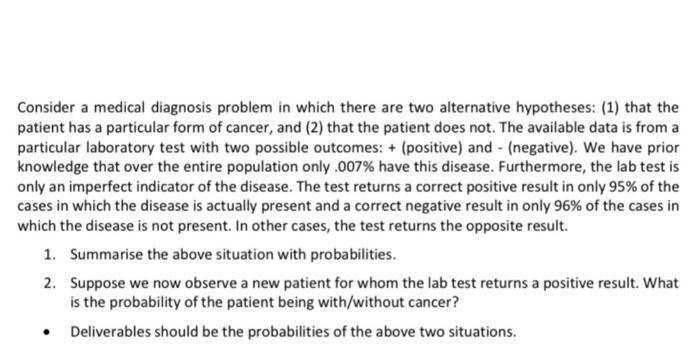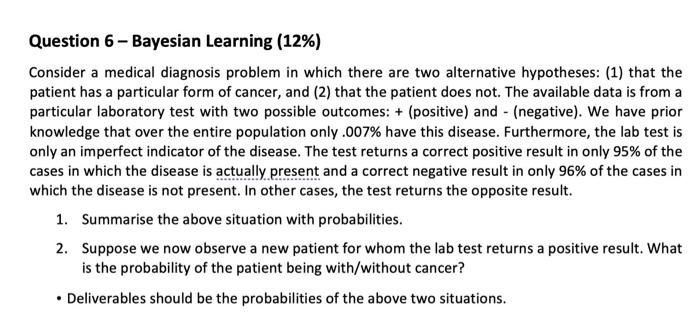
Question 6 - Bayesian Learning (12%) Consider a medical diagnosis problem in which there are two alternative hypotheses: (1) that the patient has a particular form of cancer, and (2) that the patient does not. The available data is from a particular laboratory test with two possible outcomes: + (positive) and - (negative). We have prior knowledge that over the entire population only.007% have this disease. Furthermore, the lab test is only an imperfect indicator of the disease. The test returns a correct positive result in only 95% of the cases in which the disease is actually present and a correct negative result in only 96% of the cases in which the disease is not present. In other cases, the test returns the opposite result. 1. Summarise the above situation with probabilities. 2. Suppose we now observe a new patient for whom the lab test returns a positive result. What is the probability of the patient being with/without cancer? Deliverables should be the probabilities of the above two situations. . Consider a medical diagnosis problem in which there are two alternative hypotheses: (1) that the patient has a particular form of cancer, and (2) that the patient does not. The available data is from a particular laboratory test with two possible outcomes: + (positive) and - (negative). We have prior knowledge that over the entire population only.007% have this disease. Furthermore, the lab test is only an imperfect indicator of the disease. The test returns a correct positive result in only 95% of the cases in which the disease is actually present and a correct negative result in only 96% of the cases in which the disease is not present. In other cases, the test returns the opposite result 1. Summarise the above situation with probabilities. 2. Suppose we now observe a new patient for whom the lab test returns a positive result. What is the probability of the patient being with/without cancer? Deliverables should be the probabilities of the above two situations. . Question 6 - Bayesian Learning (12%) Consider a medical diagnosis problem in which there are two alternative hypotheses: (1) that the patient has a particular form of cancer, and (2) that the patient does not. The available data is from a particular laboratory test with two possible outcomes: + (positive) and - (negative). We have prior knowledge that over the entire population only.007% have this disease. Furthermore, the lab test is only an imperfect indicator of the disease. The test returns a correct positive result in only 95% of the cases in which the disease is actually present and a correct negative result in only 96% of the cases in which the disease is not present. In other cases, the test returns the opposite result. 1. Summarise the above situation with probabilities. 2. Suppose we now observe a new patient for whom the lab test returns a positive result. What is the probability of the patient being with/without cancer? Deliverables should be the probabilities of the above two situations









